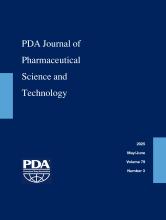Abstract
The use of amplified Adenosine Trisphosphate (ATP) Bioluminescence has been established within AstraZeneca as a technique for assessing the sterility of drug product formulations. A platform validation was generated which challenged the technology with a range of organisms and inoculum levels, and the approach to onboarding additional drug products has been designed to maximise the understanding of the drug product behaviour when samples may be limited during the development phases of the life-cycle of a drug product. Many activities to support sterility assurance take place during development; however, sterile material manufactured under Good Manufacturing Practice (GMP) conditions may not always be available. For example, during studies to understand the bacterial retention of sterilising grade filters. In cases of bactericidal products, the use of surrogates may be justified if they are suitably representative of the final drug product formulation. It may not be possible to secure GMP facility access to prepare such surrogate formulations; in those cases the principles of GMP may be applied in a controlled laboratory setting. The rapid sterility test was used to provide the sterility assurance of the prepared surrogate material. In this case study, the application of amplified ATP Bioluminescence sterility testing, enabled a fast response, to ensure mitigations could be executed in a timely manner, which meant overarching project plans could be met. The case study provides information on the rapid identification technique used to identify the slow growing and difficult to recover organism which allowed faster indication of a non-sterile material. The example also highlights some of the aspects of the challenges of culturing microorganisms and the value of modern techniques in their ability to indicate a quality drift. Dermacoccus nishinomiyaensis was isolated from the test article, and throughout the investigation, it was not possible to culture this organism on standard tryptic soya agar.
- Dermacoccus nishinomiyaensis
- Rapid microbiology methods
- microbial identification
- rapid sterility testing
- sterility assurance
- sterility testing
- Received April 19, 2022.
- Accepted June 5, 2023.
- Copyright © 2023, Parenteral Drug Association
PDA members receive access to all articles published in the current year and previous volume year. Institutional subscribers received access to all content. Log in below to receive access to this article if you are either of these.
If you are neither or you are a PDA member trying to access an article outside of your membership license, then you must purchase access to this article (below). If you do not have a username or password for JPST, you will be required to create an account prior to purchasing.
Full issue PDFs are for PDA members only.
Note to pda.org users
The PDA and PDA bookstore websites (www.pda.org and www.pda.org/bookstore) are separate websites from the PDA JPST website. When you first join PDA, your initial UserID and Password are sent to HighWirePress to create your PDA JPST account. Subsequent UserrID and Password changes required at the PDA websites will not pass on to PDA JPST and vice versa. If you forget your PDA JPST UserID and/or Password, you can request help to retrieve UserID and reset Password below.






